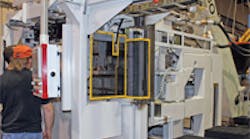Aeration techniques have been used in sand casting for material transfer for a long time. However, the application and mechanism of fluidization is different. In sand molding, aeration has recently been studied. In the molding application, green sand is fluidized by passing air through a microporous filter media; the term coined for this filling technique is, “aeration.”
In the aeration technique, molding sand is first fluidized, which greatly increases the flowability of the sand. Then low air pressure is applied to drive it into the mold, with smooth filling. Aeration filling offers a means for filling a mold cavity, with features positioned in any orientation.
Complete sand filling and uniformly dense molds are possible by aeration. Furthermore, because the area of the blow nozzle is large, the speed of sand projection through the nozzle is much lower than the conventional high-pressure blow method. The composite action of fluidization and controlled flow make it possible to achieve uniformly dense molds even in areas having complicated configurations and/or pockets having a small diameter. Even with the air pressure much lower than high-pressure blow, the bulk density obtained in aeration is generally higher.
A study on aeration using silica sand performed in 2008 at Western Michigan University showed that aeration could produce better quality molds. In aeration filling, most green sand properties (green compressive strength, permeability, mold hardness etc.) are similar to gravity filling technique. Friability however is less in aeration.
Friability is the bulk surface abrasive property of green sand, which relates erosion of green sand due to molten metal flow. The same study showed that with aeration friability remains below 10% at 30% compatibility, using silica sands at laboratory conditions. This implies that aeration can produce molds in lower compatibility levels than the conventional range of 35-38%.
In comparison, with 0.5 MPa blow pressure used for highpressure blow systems, less than 0.1MPa is used in aeration filling. The result is that the energy consumption will be lower. Further, low-pressure aeration has substantially lower noise during the mold filling process. The closed aeration system reduces the sand spillage and low-pressure equipment normally needs less maintenance. Therefore, it is easy to maintain the cleanliness in the shop floor, as the spillage can be contained easily.
To summarize, the benefits of aeration over conventional molding techniques are as follows:
Molding and filling advantages:
• Lower friability
• Higher flowability
• Uniform density
• Fill in any orientation
• Can produce molds at lower compatibility levels
Environmental benefits:
• Low energy
• Low noise
Foundry maintenance benefits:
• Closed-loop system
• Low air pressure
Dr. Sam Ramrattan is a professor of Industrial and Manufacturing Engineering at Western Michigan University.










